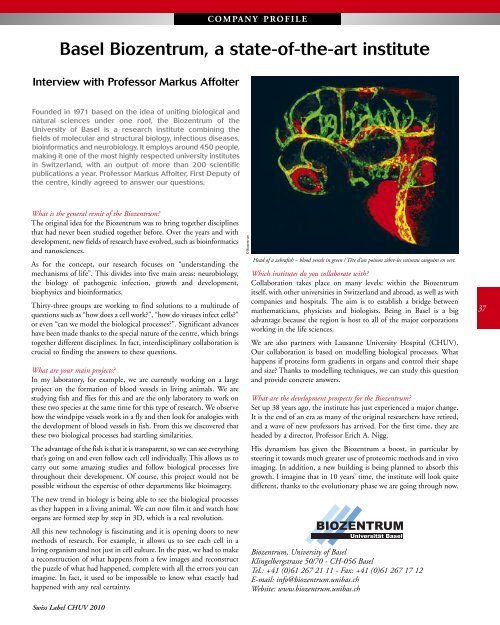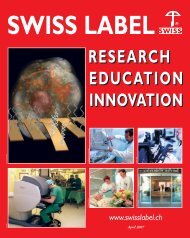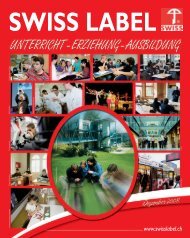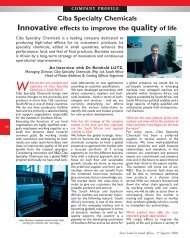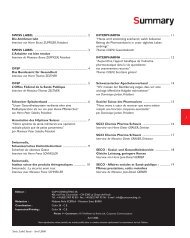SWISS LABEL INFORMATIQUE-XP - Com Consulting SA
SWISS LABEL INFORMATIQUE-XP - Com Consulting SA
SWISS LABEL INFORMATIQUE-XP - Com Consulting SA
Create successful ePaper yourself
Turn your PDF publications into a flip-book with our unique Google optimized e-Paper software.
Basel Biozentrum, a state-of-the-art instituteInterview with Professor Markus AffolterC O M PA N Y P RO F I L EFounded in 1971 based on the idea of uniting biological andnatural sciences under one roof, the Biozentrum of theUniversity of Basel is a research institute combining thefields of molecular and structural biology, infectious diseases,bioinformatics and neurobiology. It employs around 450 people,making it one of the most highly respected university institutesin Switzerland, with an output of more than 200 scientificpublications a year. Professor Markus Affolter, First Deputy ofthe centre, kindly agreed to answer our questions.What is the general remit of the Biozentrum?The original idea for the Biozentrum was to bring together disciplinesthat had never been studied together before. Over the years and withdevelopment, new fields of research have evolved, such as bioinformaticsand nanosciences.As for the concept, our research focuses on “understanding themechanisms of life”. This divides into five main areas: neurobiology,the biology of pathogenic infection, growth and development,biophysics and bioinformatics.Thirty-three groups are working to find solutions to a multitude ofquestions such as “how does a cell work?”, “how do viruses infect cells?”or even “can we model the biological processes?”. Significant advanceshave been made thanks to the special nature of the centre, which bringstogether different disciplines. In fact, interdisciplinary collaboration iscrucial to finding the answers to these questions.What are your main projects?In my laboratory, for example, we are currently working on a largeproject on the formation of blood vessels in living animals. We arestudying fish and flies for this and are the only laboratory to work onthese two species at the same time for this type of research. We observehow the windpipe vessels work in a fly and then look for analogies withthe development of blood vessels in fish. From this we discovered thatthese two biological processes had startling similarities.The advantage of the fish is that it is transparent, so we can see everythingthat’s going on and even follow each cell individually. This allows us tocarry out some amazing studies and follow biological processes livethroughout their development. Of course, this project would not bepossible without the expertise of other departments like bioimagery.The new trend in biology is being able to see the biological processesas they happen in a living animal. We can now film it and watch howorgans are formed step by step in 3D, which is a real revolution.All this new technology is fascinating and it is opening doors to newmethods of research. For example, it allows us to see each cell in aliving organism and not just in cell culture. In the past, we had to makea reconstruction of what happens from a few images and reconstructthe puzzle of what had happened, complete with all the errors you canimagine. In fact, it used to be impossible to know what exactly hadhappened with any real certainty.Swiss Label CHUV 2010© BiozentrumHead of a zebrafish – blood vessels in green / Tête d’un poisson zèbre-les vaisseau sanguins en vert.Which institutes do you collaborate with?Collaboration takes place on many levels: within the Biozentrumitself, with other universities in Switzerland and abroad, as well as withcompanies and hospitals. The aim is to establish a bridge betweenmathematicians, physicists and biologists. Being in Basel is a bigadvantage because the region is host to all of the major corporationsworking in the life sciences.We are also partners with Lausanne University Hospital (CHUV).Our collaboration is based on modelling biological processes. Whathappens if proteins form gradients in organs and control their shapeand size? Thanks to modelling techniques, we can study this questionand provide concrete answers.What are the development prospects for the Biozentrum?Set up 38 years ago, the institute has just experienced a major change.It is the end of an era as many of the original researchers have retired,and a wave of new professors has arrived. For the first time, they areheaded by a director, Professor Erich A. Nigg.His dynamism has given the Biozentrum a boost, in particular bysteering it towards much greater use of proteomic methods and in vivoimaging. In addition, a new building is being planned to absorb thisgrowth. I imagine that in 10 years’ time, the institute will look quitedifferent, thanks to the evolutionary phase we are going through now.Biozentrum, University of BaselKlingelbergstrasse 50/70 - CH-056 BaselTel.: +41 (0)61 267 21 11 - Fax: +41 (0)61 267 17 12E-mail: info@biozentrum.unibas.chWebsite: www.biozentrum.unibas.ch37


